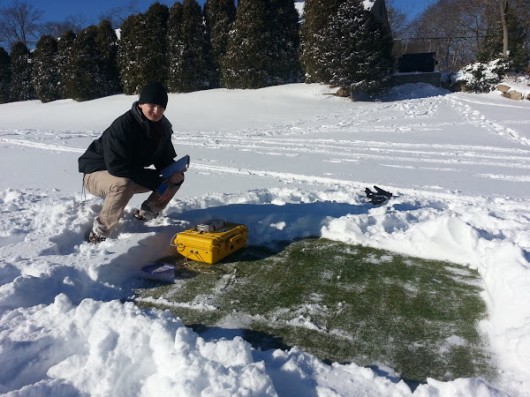I always enjoy informally talking to students who are interested in studying the environment. I find it very rewarding to share my enthusiasm for environmental science, and make a difference in a student’s education through mentorship. As previous mentors have done for me, I want to excite students about studying the environment and the Arctic in hope that they too consider pursuing this field in college.
Recently, I’ve had the opportunity to meet with the biology and environmental studies teachers at Falmouth Academy (FA), and express my desire to educate high school students about emerging issues in the Arctic. These teachers were so happy that I reached out to them that we jumped right into talking about presentations, outdoor laboratory demonstrations, and opportunities to work with students. It was then that I learned about the FA annual science fair, a school-wide science fair that enables students to work on a research project with scientists in Woods Hole. Lo and behold, I became a student mentor and soon to be judge for the FA science fair…now I was the one who was thrilled!
For a couple months now, I’ve been a mentor for bright 10th grade student, Alex. We’ve worked together on a project that involves interpreting a dataset of CO2 emissions from a permafrost warming experiment in Alaska, and an experiment to measure winter ground respiration of CO2 at different ecosystem types in Woods Hole. I’ve looked to educate Alex on the effects of global warming on permafrost degradation in the Arctic, while also allowing him to apply his studies to the Woods Hole area.
On a recent Saturday following a very snowy evening, Alex and I trekked through almost a foot of snow with a CO2 gas analyzer in hand. We were on a mission to measure ground respiration at field sites of his choice. We went out to a common neighborhood forest, a coastal wetland, and a golf course hoping to see CO2 emissions, and differences among sites. I guided Alex through good field techniques, such as making observations, taking good notes, and including replication in his experiment. During our expedition, I also encouraged Alex to “think like a scientist” and formulate his own research questions, such as what common ecosystem types in Woods Hole emit CO2? Why might we see a difference between these sites, and are there significant CO2 emissions from the ground even during the winter? Overall, our expedition made for an excellent learning experience and a great field day. With some awesome results to analyze, Alex is working hard to bring together his research project for the upcoming fair on February 13.
During my time working with Alex, I’ve really enjoyed guiding him through the challenges and excitement of conducting a research project, but have also enjoyed seeing his interest in the environment and Arctic grow. This upcoming spring, I plan on giving a presentation about my experiences with the Polaris Project to classes at FA and am planning an outdoor lab demonstration to give a lesson on ground respiration of CO2 in Falmouth.
Even in the cold and snowy conditions of western Massachusetts, there is cool science to discover!
Cheers everyone!
Craig

Alex measuring winter respiration (under a foot of snow) at a nearby golf course.




Comments(2)-
-
Anita Hunt says
January 21, 2014 at 3:07 amThank you! Your enthusiasm, and your participation in mentoring is what makes a difference with students, regardless of the subject. Real people interacting with real life to bring new knowledge,and insight, on topics they must reluctantly read about from scribbled textbook pages, changes the whole picture for them. How I wish there were more people who would follow your example! In my book, you are definitely in the Hero chapter! 🙂
Islombek says
July 28, 2015 at 1:39 amHi there!
I just wanted to ask how did you measure the amount of carbon dioxide gas that was released during your methods?
Islombek